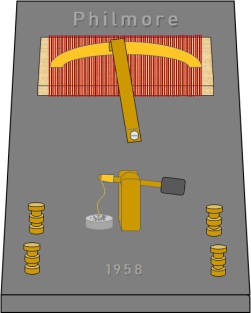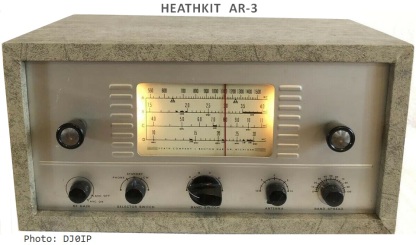My Introduction to Ham Radio
Like with many other hams, it all started with a Crystel Set Receiver.
My First Receiver:
Philmore Crystal Set
In 1958 my father gave me a Crystel Set 'kit'.
He helped me build it.
It had a very solid plastic base. The coil was wrapped onto a piece of wood. Tuning was accomplished with a brass slider along the top side of the coil. There was no capacitor.
It looked like my drawing on the right: -->
It had 4 connectors: 2 for the headphones, 1 for antenna, and 1 for ground/earth.
We ran an enamel insulated wire out the window to a tree, using an insulator made from a broken Coca Cola glass bottle- neck. The ground connectio was an insulated wire was run to a water pipe.
The headphones were black plastic and kind of hurt the ears, but I didn't care. I was the proudest kid on the block with this radio!
At the time we were living in or rather near Chicago. I can't recall which stations I could receive, maybe WLS. That was a long time ago.
In April of 1959, my family moved to Zweibruecken, Germany.
We lived on the 2nd floor of a large 3-story appartment house.
I ran an enamel insulated wire out the window, across the street and to a lamp post on the other side of the street. I connected the ground wire to the heater/radiator. This was a great antenna and I was able to receive all kinds of stations in several languages, foreign to me. I could also receive American Forces Network (AFN) and Canadian Forces Network (CFN) in English.
One day as I was listening to my Xtal Set, suddenly a BOOMING LOUD signal came in over everything. It hurt my ears so badly, I threw the headphones from my head. It soon disapearred. I had no idea what it was.
This became a regular occurance.
I found if I removed the antenna lead and only used the ground attachment, I was able to copy the signal at a comfortable level.
To my surprise, the voice was speaking American English. Occasionally he said "DL4EU". I can't recall his first name; for me he was Captain Dixon.
I listened with enthusiasm for hours on end, wondering why I couldn't hear the person he was talking to. Eventually he gave his address over the air. I wrote it down and went looking for it. Found it directly next to the lamp pole that my antenna was running to.
In the evening I returned and rang his doorbell. I was greeted by a pleasant young man who laughed as I told him my story. He invited me in, demonstrated a QSO and the bug bit me.
I had to have a "real" receiver.
Initially I chose a Knightkit "Ocean Hopper" which was a super-regenerative receiver. Capt. Dixon talked me out of that and recommended I purchase Heathkit AR-3, a super-hetrodyne receiver.
I ordered the kit in time for Christmas, 1958, and built it (under his surveillance) in January of 1959. By February I was good to go; happier than a kid in a candy store.



























